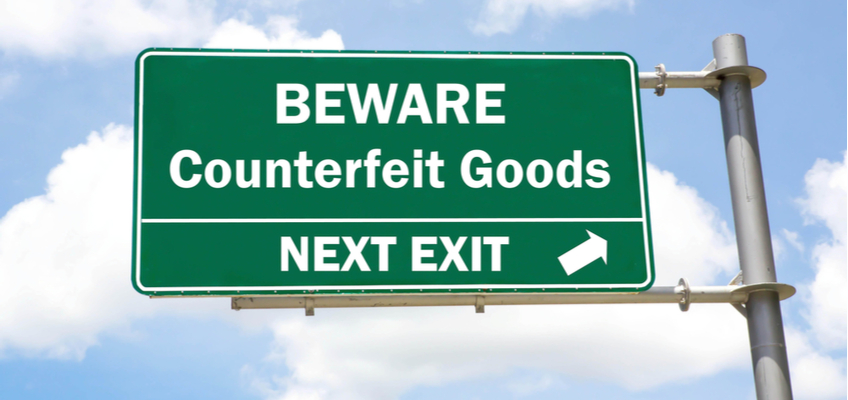
Amazon is Cracking Down on Counterfeit Products — Here’s What eSellers Need to Know
Fake goods cost retail brands real money. Today, over 2 million products are listed each day on marketplaces such as Amazon and Alibaba, making it so that at any given point, there are over 1 billion counterfeit goods listed online. According to the International Trademark Association (INTA), the counterfeit goods industry is expected to grow to over $4.2 billion by 2022. Beyond harming brand reputation and revenue generation, counterfeit goods can hurt consumers.
The war on counterfeit goods recently escalated after marketplace leader Amazon announced to investors that they could put their company at risk. This is due to the increased pressure from brands to crackdown on the sale of counterfeit goods or risk being held accountable.
Want to learn more about what Amazon is doing to crack down on the sale of counterfeit goods? Continue reading below:
The Problem of Counterfeit Amazon Goods
According to The Counterfeit Report (TCR), an advocacy group that works with brands to detect fake goods, around 58,000 counterfeit products have been found on Amazon since May 2016. While more than 35,000 items have been removed, the problem continues to grow. According to the 2018 Global Brand Counterfeiting Report, the amount of total counterfeiting globally reached to USD 1.2 trillion in 2017 and is projected to reach USD 1.82 trillion by the year 2020.
Amazon’s Warning to Investors
Amazon recognizes the impact of counterfeit goods and the risk they pose.
In a recent annual report, Amazon warned investors that their main problem lies in their inability “to prevent sellers in our stores or through other stores from selling unlawful, counterfeit, pirated, or stolen goods.”
The main culprits putting Amazon at risk are the third-party merchants. The problem here is that 52% of all products sold on the site were from third-party merchants, making this their largest customer base.
What’s most frustrating to consumers — and Amazon — is that some of the counterfeit items bear the seemingly trustworthy Fulfilled by Amazon (FBA) label. The reality is that while the FBA label only indicates that Amazon serves as the distributing agency, it also provides many consumers with a false sense of buyer security.
Enter Amazon’s Project Zero
In the past, Amazon only reacted to fraudulent sellers after numerous complaints, or if an official brand filed a counterfeit report. This caused dissatisfaction among many eSellers, as they reported feeling as though Amazon didn’t care enough about the seriousness of the situation.
The retail giant has launched a new anti-counterfeiting initiative called “Project Zero” that aims to tackle the counterfeit problem while protecting sellers and consumers alike.
According to the company, the program uses three tools:
- Automated protections— Brands provide their logos, trademarks and other key brand data. Amazon then uses AI to scan over 5 billion product listing updates daily to find suspected counterfeits.
- Self-service counterfeit removal tools — In the past, brands would report a counterfeit product to Amazon, and they would then investigate these reports and take action. Now brands can remove counterfeit listings themselves.
- Product serialization — This service gives a unique code for every unit produced. Brands then put these codes on each product. Every time a listed product is purchased, Amazon can scan the serial code and verify the authenticity of the purchase.
The Good News and the Bad News
The good news is that Amazon appears to be making a very concerted effort to stop the sale of counterfeit products. This is a blessing for legitimate sellers looking to provide top quality goods on the online marketplace.
Amazon has been running pilots with several brands — including Vera Bradley, mobile accessories maker Kenu, and anti-anxiety products manufacturer ThunderWorks — with positive results. Since the new solution was implemented, Amazon has been able to thwart 100 times more suspected counterfeit products compared to what the site reactively removed based on brands’ reports.
The bad news is that protections aren’t yet widely available.
While the program is now being opened up to additional brand owners, there is a waitlist and added fee associated with joining. Once a seller joins “Project Zero” they do not get a 100% guarantee.
While Amazon is committed to “providing brands with an unprecedented level of responsibility”, they also emphasize that sellers “must maintain a high bar for accuracy in order to maintain their Project Zero privileges.” This includes training and monitoring to avoid misuse, among other requirements.
What eSellers Can Do About Counterfeit Sales
The steps that Amazon is taking will no doubt benefit eSellers in the future. For now, however, the problem is still a very real one that they must deal with. While Amazon may not be able to drive counterfeiters out of business or entirely off their platform, they are making it harder for fraudsters to succeed, providing consumers with a stronger sense of protection.
If your brand suffers revenue loss and brand reputation damage due to the sale of counterfeit goods on Amazon, the best course of action is to apply to “Project Zero” while taking actions to protect your brand and customers.
At the end of the day, your eSeller brand is your reputation — and you can’t put a price on that.




